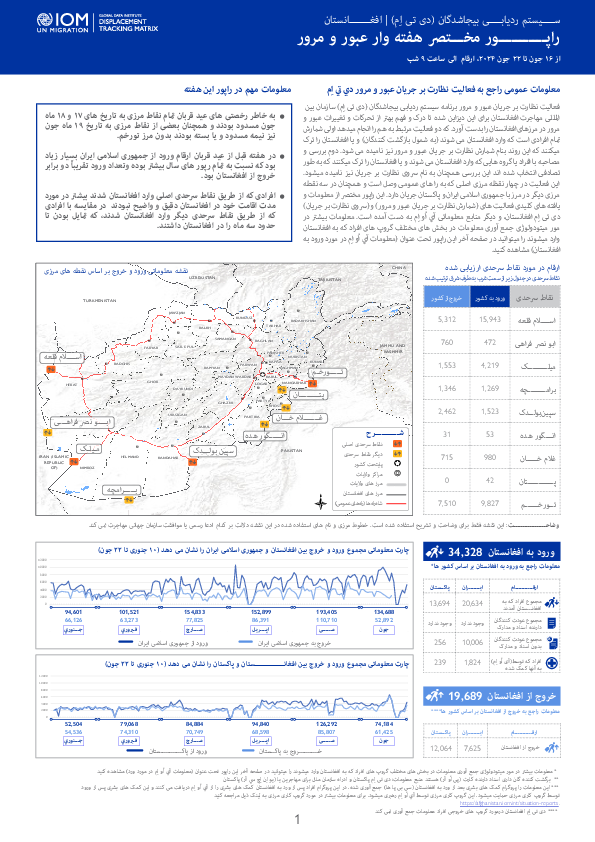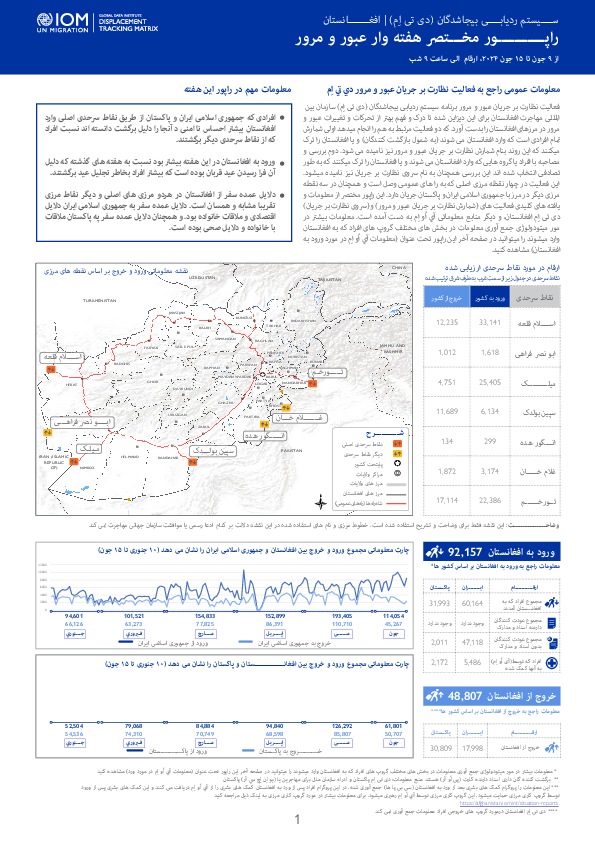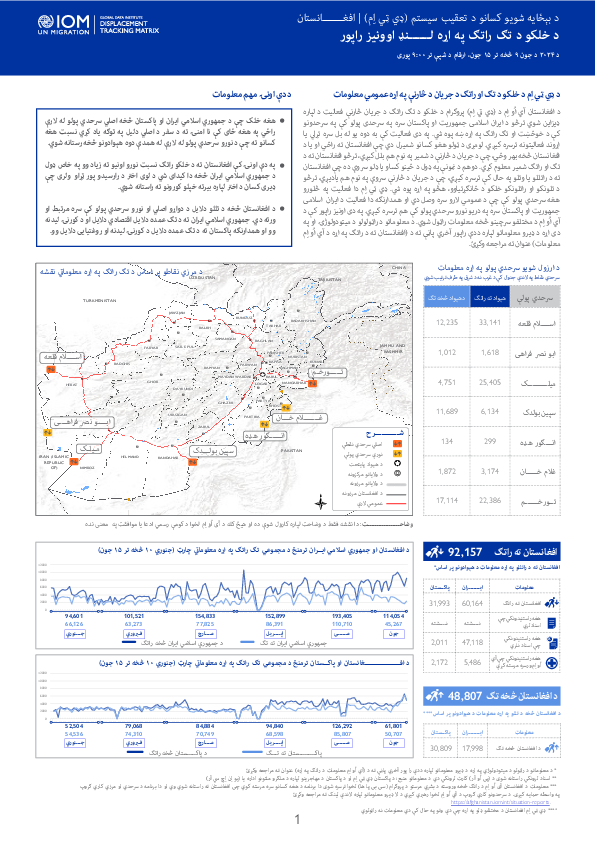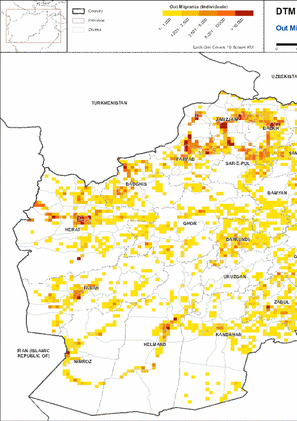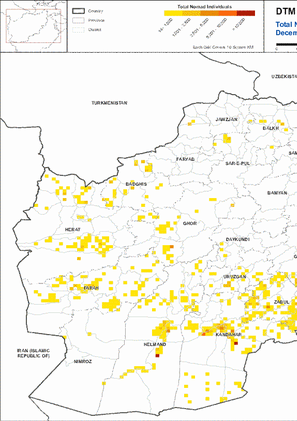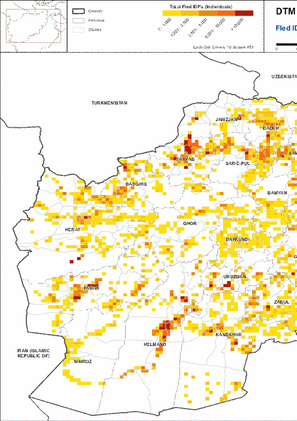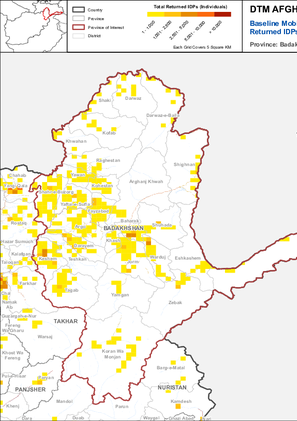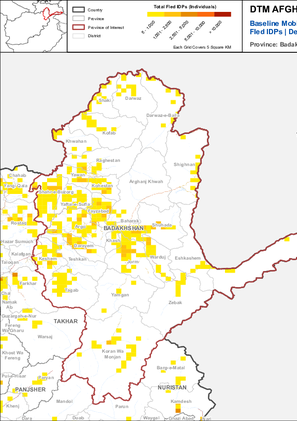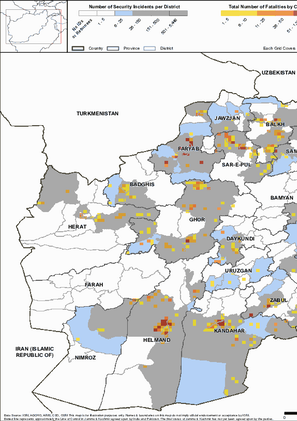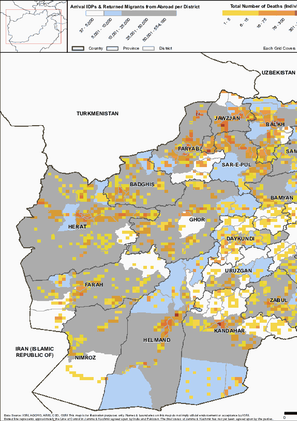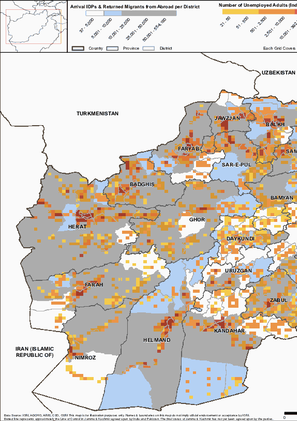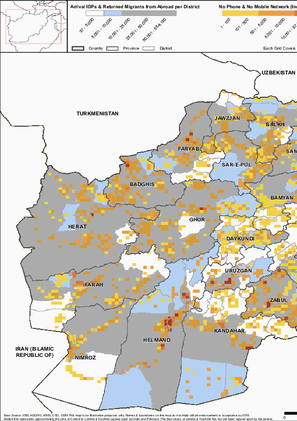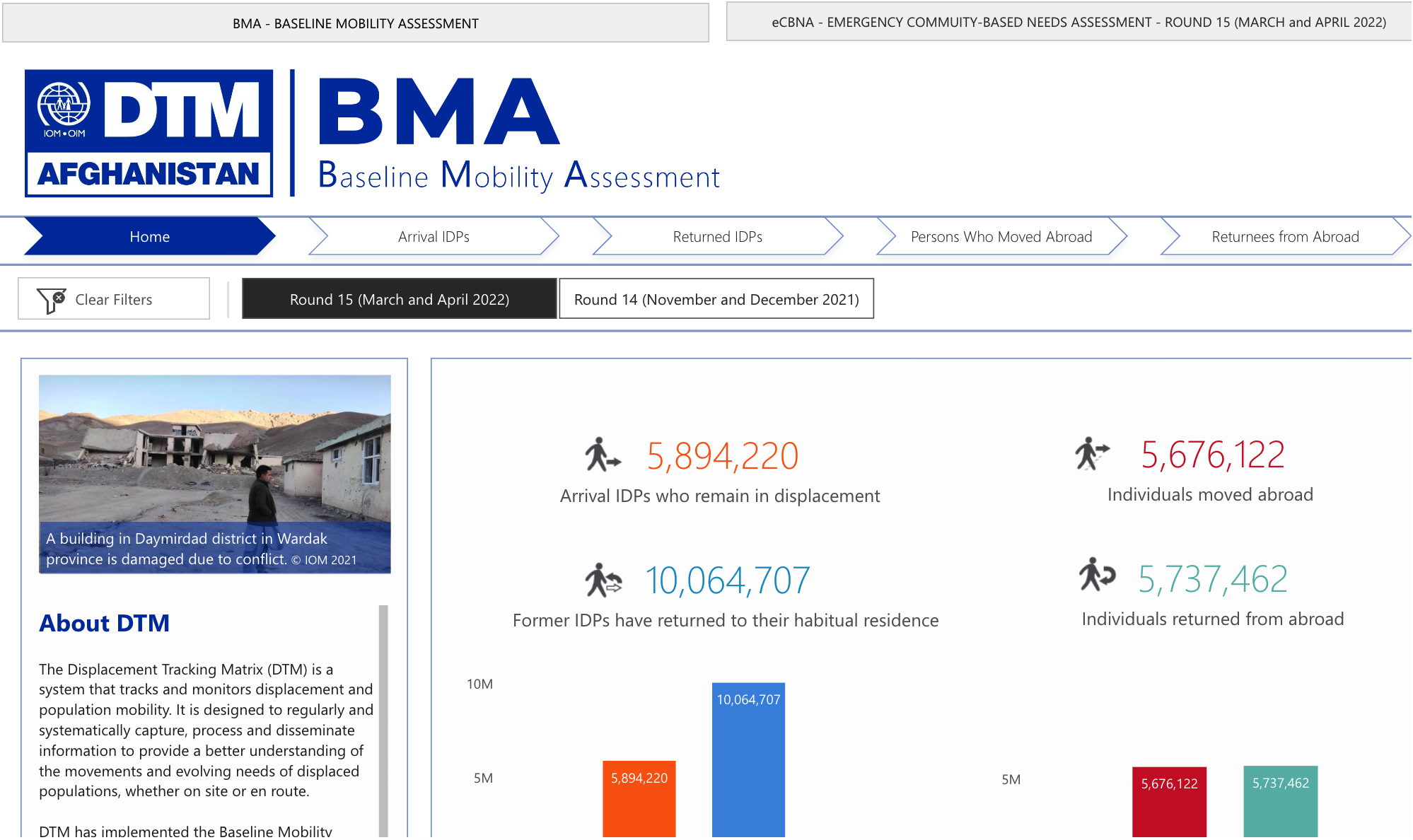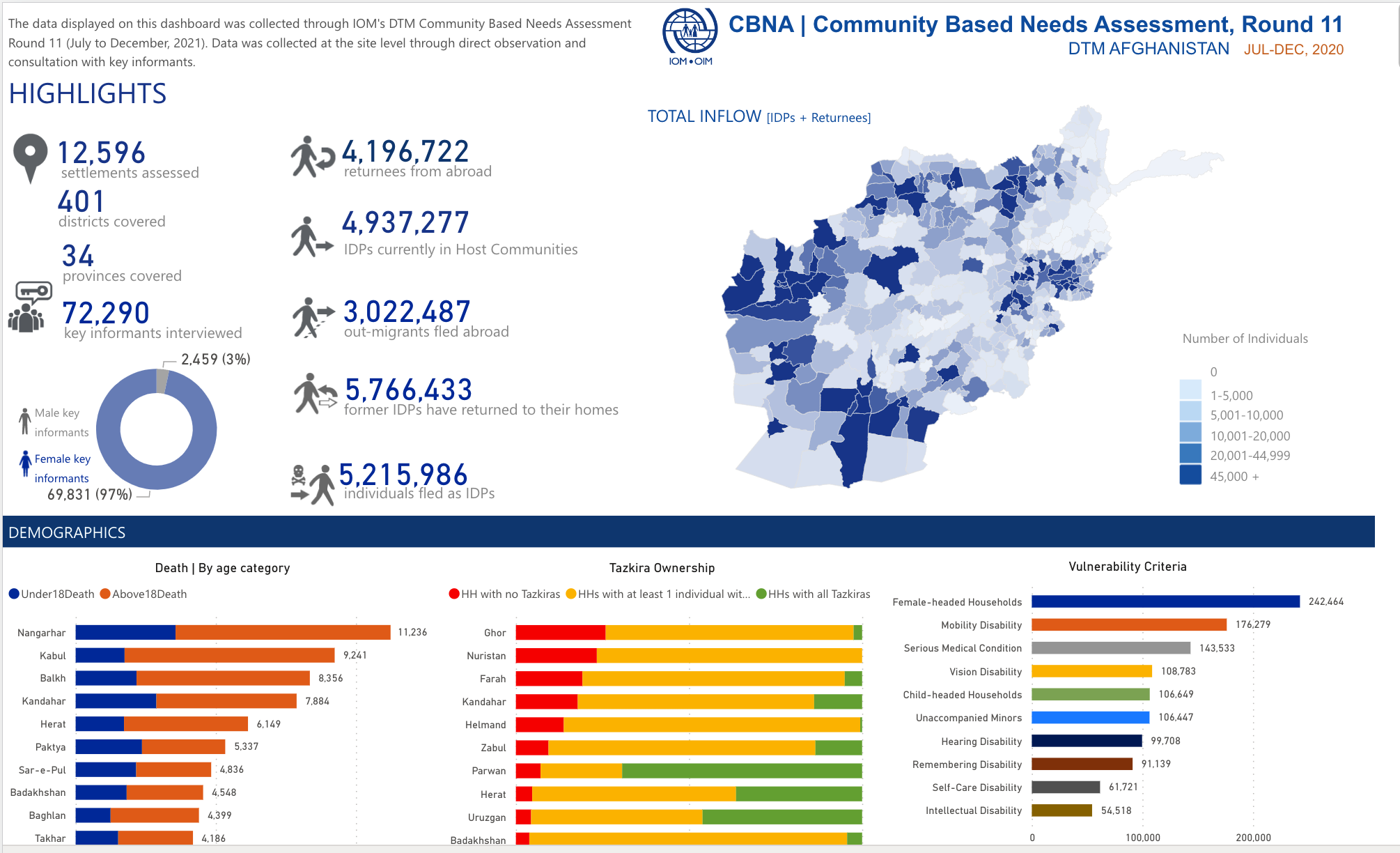-
Countries
-
Data and Analysis
-
Special Focus
-
Crisis Responses
Asia and the Pacific
DTM Asia and the Pacific
DTM Operations in the region
- Active DTM operation
- Past DTM operation
Afghanistan - Flow Monitoring Snapshot (14-20 July 2024) [ENG]
The IOM Afghanistan’s DTM Flow Monitoring activity is designed to provide insights into the mobility patterns at Afghanistan’s border points with the Islamic Republic of Iran and Pakistan.
افغانستان - راپور مختصر جریان عبور و مرور (۱۴ - ۲۰ جولای ۲۰۲۴) [DARI]
فعالیت نظارت بر جریان عبور و مرور برنامه سیستم ردیابی بیجاشدگان (دی تی اِم) سازمان بین المللی مهاجرت افغانستان برای این دیزاین شده تا درک و فهم بهتر از تحرکات و تغییرات عبور و مرور در مرزهای افغانستان را بدست آورد.
افغانستان - د خلکو د تګ راتګ په اړه لنډ راپور (۱۴ - ۲۰ جولای ۲۰۲۴) [PASHTO]
د افغانستان آي اُو اِم د (ډي تي اِم) پروګرام د خلکو د تګ راتګ د جریان څارنې فعالیت د لپاره ډیزاین شوي ترڅو د ایران اسلامی جمهوریت او پاکستان سره په سرحدی پولو کې په سرحدونو کې د خوځښت او تګ راتګ په اړه ښه پوه شي.
Pakistan – Afghan Response Community Needs Identification (CNI) | Round 1 | August – September 2023
The International Organization for Migration’s (IOM) CNI is used to provide a baseline on living conditions and needs of Afghan nationals in identified settlements rather than providing a detailed overview of multisectoral needs.
ประเทศไทย - การประเมินความต้องการหลายภาคส่วน พ.ศ. 2566 - จังหวัดเชียงใหม่ (Chiang Mai province)
บทสรุป: สรุปข้อมูลสำคัญนี้มีจุดมุ่งหมายเพื่อนำเสนอภาพรวมของสภาวการณ์ ความต้องการ และความท้าทายตามประเด็นหัวข้อต่าง ๆ ในหมู่ผู้ย้ายถิ่นชาวเมียนมาในจังหวัดเชียงใหม่ที่ไอโอเอ็ม ประเทศไทยได้ดำเนินการประเมินความต้องการหลายภาคส่วนระหว่างเดือนตุลาคม พ.ศ. 2566 ถึงมกราคม พ.ศ. 2567 เพื่
Afghanistan - Flow Monitoring Snapshot (7-13 July 2024) [ENG]
The IOM Afghanistan’s DTM Flow Monitoring activity is designed to provide insights into the mobility patterns at Afghanistan’s border points with the Islamic Republic of Iran and Pakistan.
افغانستان - راپور مختصر جریان عبور و مرور (۷ - ۱۳ جولای ۲۰۲۴) [DARI]
فعالیت نظارت بر جریان عبور و مرور برنامه سیستم ردیابی بیجاشدگان (دی تی اِم) سازمان بین المللی مهاجرت افغانستان برای این دیزاین شده تا درک و فهم بهتر از تحرکات و تغییرات عبور و مرور در مرزهای افغانستان را بدست آورد.
افغانستان - د خلکو د تګ راتګ په اړه لنډ راپور (۷ - ۱۳ جولای ۲۰۲۴) [PASHTO]
د افغانستان آي اُو اِم د (ډي تي اِم) پروګرام د خلکو د تګ راتګ د جریان څارنې فعالیت د لپاره ډیزاین شوي ترڅو د ایران اسلامی جمهوریت او پاکستان سره په سرحدی پولو کې په سرحدونو کې د خوځښت او تګ راتګ په اړه ښه پوه شي.
Afghanistan - Flow Monitoring Quarterly Report 2 (April - June 2024) [ENG]
Frequent movement at the borders with the Islamic Republic of Iran and Pakistan have been influenced by a variety of factors over the past few decades.
افغانستان - د خلکو د تګ راتګ په اړه لنډ راپور (۳۰ جون - ۶ جولای ۲۰۲۴) [PASHTO]
د افغانستان آي اُو اِم د (ډي تي اِم) پروګرام د خلکو د تګ راتګ د جریان څارنې فعالیت د لپاره ډیزاین شوي ترڅو د ایران اسلامی جمهوریت او پاکستان سره په سرحدی پولو کې په سرحدونو کې د خوځښت او تګ راتګ په اړه ښه پوه شي.
Afghanistan - Flow Monitoring Snapshot (30 June - 6 July 2024) [ENG]
The IOM Afghanistan’s DTM Flow Monitoring activity is designed to provide insights into the mobility patterns at Afghanistan’s border points with the Islamic Republic of Iran and Pakistan.
افغانستان - راپور مختصر جریان عبور و مرور (۳۰ جون - ۶ جولای۲۰۲۴) [DARI]
فعالیت نظارت بر جریان عبور و مرور برنامه سیستم ردیابی بیجاشدگان (دی تی اِم) سازمان بین المللی مهاجرت افغانستان برای این دیزاین شده تا درک و فهم بهتر از تحرکات و تغییرات عبور و مرور در مرزهای افغانستان را بدست آورد.
Pakistan — Flow Monitoring of Afghan Returnees — Bi-Weekly Report (16 – 30 June 2024)
The International Organization for Migration (IOM) in Pakistan collects data on the outflows of Afghans at the Torkham (Khyber Pakhtunkhwa), Badini, Bahramcha and Chaman (Balochistan) border crossing points (BCPs) to better understand the movements of Afghans returning
Pakistan – 2024 Rainfall | Flash Update #2 | 1 April – 31 May | Khyber Pakhtunkhwa
Rainfall in Khyber Pakhtunkhwa has impacted 8 districts, resulting in widespread damage and disruption. The highest volume of rainfall was recorded in Lakki Marwat district, leading to damages to houses, landslides, flash flooding, lightning strikes,
افغانستان - د خلکو د تګ راتګ په اړه لنډ راپور (۲۳ - ۲۹ جون۲۰۲۴) [PASHTO]
د افغانستان آي اُو اِم د (ډي تي اِم) پروګرام د خلکو د تګ راتګ د جریان څارنې فعالیت د لپاره ډیزاین شوي ترڅو د ایران اسلامی جمهوریت او پاکستان سره په سرحدی پولو کې په سرحدونو کې د خوځښت او تګ راتګ په اړه ښه پوه شي.
Afghanistan - Flow Monitoring Snapshot (23 - 29 June 2024) [ENG]
The IOM Afghanistan’s DTM Flow Monitoring activity is designed to provide insights into the mobility patterns at Afghanistan’s border points with the Islamic Republic of Iran and Pakistan.
افغانستان - راپور مختصر جریان عبور و مرور (۲۳ - ۲۹ جون ۲۰۲۴) [DARI]
فعالیت نظارت بر جریان عبور و مرور برنامه سیستم ردیابی بیجاشدگان (دی تی اِم) سازمان بین المللی مهاجرت افغانستان برای این دیزاین شده تا درک و فهم بهتر از تحرکات و تغییرات عبور و مرور در مرزهای افغانستان را بدست آورد.
Pakistan — Flow Monitoring of Afghan Returnees — Bi-Weekly Report (1 – 15 June 2024)
The International Organization for Migration (IOM) in Pakistan collects data on the outflows of Afghans at the Torkham (Khyber Pakhtunkhwa), Badini, Bahramcha and Chaman (Balochistan) border crossing points (BCPs) to better understand the movements of Afghans returning to Afghanistan.
افغانستان - راپور مختصر جریان عبور و مرور (۱۶ - ۲۲ جون۲۰۲۴) [DARI]
فعالیت نظارت بر جریان عبور و مرور برنامه سیستم ردیابی بیجاشدگان (دی تی اِم) سازمان بین المللی مهاجرت افغانستان برای این دیزاین شده تا درک و فهم بهتر از تحرکات و تغییرات عبور و مرور در مرزهای افغانستان را بدست آورد.
افغانستان - د خلکو د تګ راتګ په اړه لنډ راپور (۱۶ - ۲۲ جون ۲۰۲۴) [PASHTO]
د افغانستان آي اُو اِم د (ډي تي اِم) پروګرام د خلکو د تګ راتګ د جریان څارنې فعالیت د لپاره ډیزاین شوي ترڅو د ایران اسلامی جمهوریت او پاکستان سره په سرحدی پولو کې په سرحدونو کې د خوځښت او تګ راتګ په اړه ښه پوه شي.
Afghanistan - Flow Monitoring Snapshot (16 -22 June 2024) [ENG]
The IOM Afghanistan’s DTM Flow Monitoring activity is designed to provide insights into the mobility patterns at Afghanistan’s border points with the Islamic Republic of Iran and Pakistan.
افغانستان - راپور مختصر جریان عبور و مرور (۹ - ۱۵ جون ۲۰۲۴) [DARI]
فعالیت نظارت بر جریان عبور و مرور برنامه سیستم ردیابی بیجاشدگان (دی تی اِم) سازمان بین المللی مهاجرت افغانستان برای این دیزاین شده تا درک و فهم بهتر از تحرکات و تغییرات عبور و مرور در مرزهای افغانستان را بدست آورد.
ชื่อรายงาน: ประเทศไทย - การประเมินความต้องการหลายภาคส่วน พ.ศ. 2566 - เขตกรุงเทพฯ และปริมณฑล (Greater Bangkok Area)
บทสรุป: สรุปข้อมูลสำคัญนี้มีจุดมุ่งหมายเพื่อนำเสนอภาพรวมของสภาวการณ์ ความต้องการ และความท้าทายตามประเด็นหัวข้อต่าง ๆ ในหมู่ผู้ย้ายถิ่นชาวเมียนมาในเขตกรุงเทพฯ และปริมณฑล ที่ไอโอเอ็ม ประเทศไทยได้ดำเนินการรวบรวมข้อมูลโดยการประเมินความต้องการหลายภาคส่วนของไอโอเอ็มระหว่างเดือนมิถุนายนถึงสิงหาคม พ.ศ.
افغانستان - د خلکو د تګ راتګ په اړه لنډ راپور (۹ - ۱۵ جون ۲۰۲۴) [PASHTO]
د افغانستان آي اُو اِم د (ډي تي اِم) پروګرام د خلکو د تګ راتګ د جریان څارنې فعالیت د لپاره ډیزاین شوي ترڅو د ایران اسلامی جمهوریت او پاکستان سره په سرحدی پولو کې په سرحدونو کې د خوځښت او تګ راتګ په اړه ښه پوه شي.
Pagination
Afghanistan – Baseline Area Assessment B1 – Round 1
Apr 08 2024
<p>IOM Afghanistan launched the first round of the DTM Baseline Area Assessment B1 in January 2024 as part of its ongoing efforts to collect crucial data on population mobility dynamics, specifically displacement and returns. In particular, the B1 activity seeks to map the presence of mobile…
Afghanistan - Flow Monitoring Counting (Since January 10 2024)
Jul 04 2024
<p>IOM Afghanistan's DTM Flow Monitoring activity, initiated at the beginning of 2024, seeks to quantify and better understand the mobility dynamics at Afghanistan’s borders. On 10 January 2024, DTM began deploying field teams at four border crossing points with the Islamic Republic of…
Pakistan – Community Needs Identification (Flood Response) – Round 4
Mar 15 2024
<p>In round 4, <strong>1,340,621</strong> TDP individuals and <strong>2,633,435</strong> TDP returnees were identified in Khyber Pakhtunkhwa, Balochistan, and Sindh province.</p>
Pakistan - Flow Monitoring Registry - 2023
Mar 06 2024
<p>The International Organization for Migration (IOM) in Pakistan collects data on the outflows of Afghans at the Torkham (Khyber Pakhtunkhwa) and Chaman (Balochistan) border crossing points (BCPs) to better understand the movements of Afghans returning to Afghanistan. The dataset is…
Pakistan – Community Needs Identification (Flood Response) – Round 3
Nov 02 2023
<p><strong>1,554,411</strong> TDP individuals and <strong>202,161</strong> TDP households were identified in Khyber Pakhtunkhwa, Balochistan, and Sindh province in Round 3.</p>
Mongolia — Rapid Assessment - Migration, Population and Needs - Nationwide (June - September 2022)
Sep 13 2023
This dataset covers 1,640 baghs in 21 provinces of Mongolia. 504,554 households and 1, 779,600 individuals were identified. 36.5 percent of the population (649,000 individuals) were registered as minors below the age of 18; 55.6 percent (988,700 individuals) were registered as adults aged 18–59…
Mongolia — Rapid Assessment - Migration, Population and Needs - Round 3 (September 2022 to February 2023)
Aug 08 2023
At the time of the round 3 assessment, there were 1,640,758 individuals and 474,198 households living in Ulaanbaatar city. Fifty-three per cent were women and 47 per cent were men. A significant 35 per cent of the population registered as minors: 12 per cent aged 0–5 years, and 23 per cent aged 6–…
Pakistan - Flow Monitoring Registry - 2017
Aug 03 2023
Since January 2017, overall, 97,225 returnees have been reported returning through Torkham and Chaman/Spin Boldak.
Pakistan - Flow Monitoring Registry - 2018
Aug 03 2023
During this period, the Displacement Tracking Matrix (DTM) recorded 30,413 Afghan nationals returning to Afghanistan from Pakistan through the Torkham (55%) and Chaman (45%) border crossings. One in two recorded returnees was a child (56%). Out of the total returnees, 71 per cent were undocumented…
Pakistan - Flow Monitoring Registry - 2021
Aug 03 2023
27,829 undocumented returnees were reported to have crossed the two borders, out of which 14,185 were females and 13,644 were males. Additionally, border authorities facilitated the return of 1,740 individuals due to the lack of legal documentation to remain in Pakistan. Therefore, information…
Pakistan - Flow Monitoring Registry - 2019
Aug 03 2023
Between January 1 and 31 December 2019, the Displacement Tracking Matrix (DTM) recorded 17,286 undocumented Afghan nationals returning from Pakistan to Afghanistan through the Chaman and Torkham border crossings, each accounting for 74 per cent and 26 percent of the total border crossings. The…
Pakistan - Flow Monitoring Registry - 2020
Aug 02 2023
The number of returnees has decreased significantly in comparison to the previous year, 6,661 individuals in 2020 compared to 17,286 in 2019. Besides a variety of push and pull factors, the steep decline in return movements can also be attributed to the closure of the borders due to the COVID-19…
Pakistan - Flow Monitoring Registry - 2022
Aug 03 2023
The number of undocumented Afghans returning from Pakistan has increased significantly, nearly threefold, in comparison to 2021. This rise in returns can be attributed to the significant geopolitical changes that took place in Afghanistan between 2021 and 2022. The data also shows that the number…
Pakistan – Community Needs Identification (Flood Response) – Round 1
Aug 02 2023
<p>An estimated total of 1,591,367 temporary displaced persons (TDPs) were identified during this round in the 18 districts of Balochistan, Khyber Pakhtunkhwa and Sindh. Fifty-five per cent of TDP households (113,070) were living in temporary structures (i.e. tents or emergency shelter).</…
Pakistan – Community Needs Identification (Flood Response) – Round 2
Jul 20 2023
<p>An estimated total of 318,829 temporary displaced persons (TDPs) were identified during round 2 in the 19 assessed districts of Balochistan and Khyber Pakhtunkhwa. Sixty per cent of TDP households (27,092) were living in temporary structures (i.e. tents or emergency shelter).</p>
Afghanistan – Community-Based Needs Assessment, Settlement Level Dataset, Round 16 (September-December 2022)
Jun 06 2023
<p>The CBNA is an integral component of DTM's Baseline Mobility Assessment (BMA), which (in a jointly released dataset) tracks mobility and displacement. The objective of the CBNA is to provide a baseline for programmatic priorities and geographical targeting of assistance, by supplying…
Afghanistan - Baseline Assessment, Settlement Level Dataset, Round 16 (September-December 2022)
Jun 06 2023
This file contains data from DTM Afghanistan's 16th round of the Baseline Mobility Assessment (BMA), which was conducted between September and December 2022. DTM has been conducting the BMA in Afghanistan since 2016 to track mobility, provide information on population estimates, locations and…
Mongolia — Rapid Assessment - Migration, Population and Needs - Round 1 (July 2022)
Apr 21 2023
This rapid assessment dataset provides an overview of key thematic areas on population, migration and needs.
Mongolia — Rapid Assessment - Migration, Population and Needs - Round 2 (June to August 2022)
Apr 21 2023
This rapid assessment dataset provides an overview of key thematic areas on population, migration and needs.
Afghanistan - Emergency Community-Based Needs Assessment - Round 15 (March-April 2022)
Jul 12 2022
Since December 2019, the Community-Based Needs Assessment (CBNA)has been included as a standard component of the Baseline Mobility Assessment (BMA) exercise as a way to provide a more comprehensive view of multi-sectoral needs in settlements hosting IDPs and returnees. In Round 15, the DTM team in…
Pagination
AFG-DTM-District-Out-Flow-To-Europe-Overview-December2021
This map provides information on Outflow to Europe (Afghans who moved to non-neighboring countries) during period of 2012 till December 2021.
AFG-DTM-District-Arrival-IDPs-Overview-December2021
This map provides information on Arrival IDPs (IDPs from other location currently residing in an assessed village) during period of 2012 till December 2021.
AFG-DTM-District-Out-Migrants-Overview-December2021
This map provides information on Out Migrants (Afghans who moved or fled abroad) During period of 2012 till December 2021.
AFG-DTM-District-Returned-IDPs-Overview-December2021
This map provides information on Returned IDPs (Afghans from an assessed village who had fled as IDPs in the past and have now returned home) During period of 2012 till December 2021.
AFG-DTM-District-Returnees-from-Abroad-Overview-December2021
This map provides information on Returnees from Abroad (Afghans who had fled abroad for at least 6 months and have now returned to Afghanistan) During period of 2012 till December 2021.
AFG-DTM-District-Total-Nomads-Individuals-Overview-December2021
This map provides information on Total Nomads Individuals during period of 2012 till December 2021.
AFG-DTM-District-Total-Nomads-Families-Overview-December2021
This map provides information on Total Nomads Families during period of 2012 till December 2021.
AFG-DTM-District-Total-Inflow-Overview-December2021
This map provides information on Total inflow (Returnees from Abroad + Arrival IDPs) during the period from 2012 through December 2021.
AFG-DTM-District-Total-Refugee-Individuals-Overview-December2021
This map provides information on Total Refugee Individuals during period of 2012 till December 2021.
AFG-DTM-District-Total -Refugee-Families-Overview-December2021
This map provides information on Total Refugee Families during period of 2012 till December 2021.
AFG-DTM-District-Total-CB-Tribal-Individuals-Overview-December2021
This map provides information on Total Cross Border Tribal Individuals during period of 2012 till December 2021.
AFG-DTM-District-Total-CB-Tribal-Families-Overview-December2021
This map provides information on Total Cross Border Tribal Families during period of 2012 till December 2021.
Afghanistan - District Map - Fled IDPs - December 2021
This map provides information on Fled IDPs (Afghans from an assessed village who fled as IDPs to reside elsewhere in Afghanistan) During period of 2012 till December 2021.
Afghanistan — Provincial Map — Total Inflow (Arrival & Returned Migrants) — December 2021
This combined map provides information on Total Inflow (Arrival & Returned Migrants) at the provincial level during the period of 2012 - December 2021.
Afghanistan — Provincial Map — Returned Migrants from Abroad — December 2021
This combined map provides information on Returned Migrants from Abroad at the provincial level during the period of 2012 - December 2021.
Afghanistan — Provincial Map — Returned IDPs — December 2021
This combined map provides information on Returned IDPs at the provincial level during the period of 2012 - December 2021.
Afghanistan — Provincial Map — Out Migrants — December 2021
This combined map provides information on Out Migrants at the provincial level during the period of 2012 - December 2021.
Afghanistan — Provincial Map — Fled IDPs — December 2021
This combined map provides information on Fled IDPs at the provincial level during the period of 2012 - December 2021.
Afghanistan — Provincial Map — Arrival IDPs — December 2021
This combined map provides information on Arrival IDPs, on provincial level during the period of 2012 - December 2021.
AFG_DTM_December2021_CBNA_Security_Incidents_and_Fatalities_in_Last_6_Months_Overview_By_District
This map provides information on total number of security incidents and fatalities in the last 6 months in villages assessed under Community Based Needs Assessment during the period from 2012 through December 2021.
AFG_DTM_December2021_CBNA_Number_of_Deaths_in_Last_3_Months_Overview_By_District
This map provides information on total number of deaths in the last 3 months in villages assessed under Community Based Needs Assessment during the period from 2012 through December 2021.
AFG_DTM_December2021_CBNA_Number_of_Unemployed_Adults_(18+)_Overview_By_District
This map provides information on number of unemployed adults (18+) in villages assessed under Community Based Needs Assessment during the period from 2012 through December 2021.
AFG_DTM_December2021_CBNA_No_Phone_&_No_Mobile_Network_Overview_By_District
This map provides information on individuals who do not have access to phone or mobile network in villages assessed under Community Based Needs Assessment during the period from 2012 through December 2021.
AFG_DTM_December2021_CBNA_No_Access_to_Markets_Overview_By_District
This map provides information on individuals who do not have access to markets in villages assessed under Community Based Needs Assessment during the period from 2012 through December 2021.


















